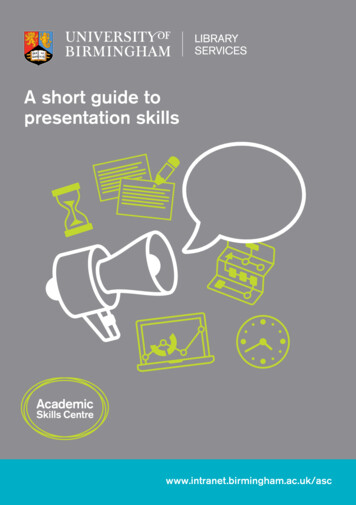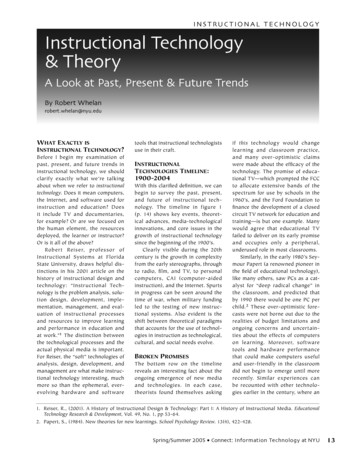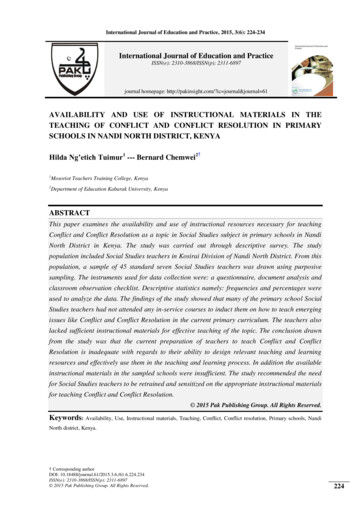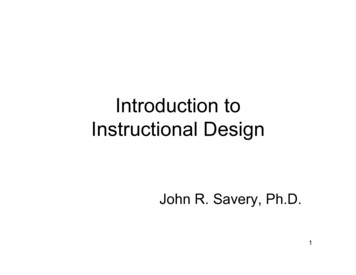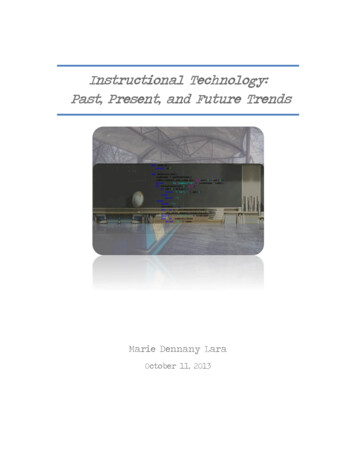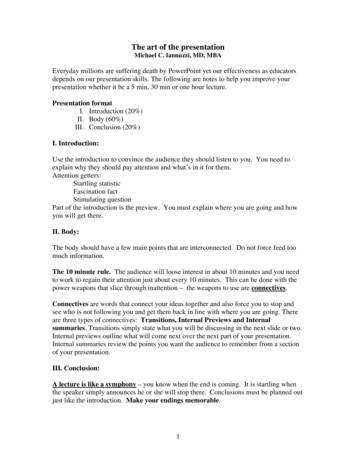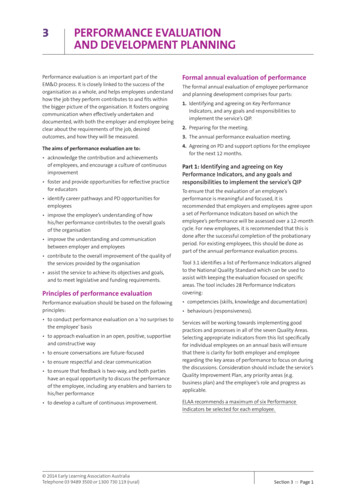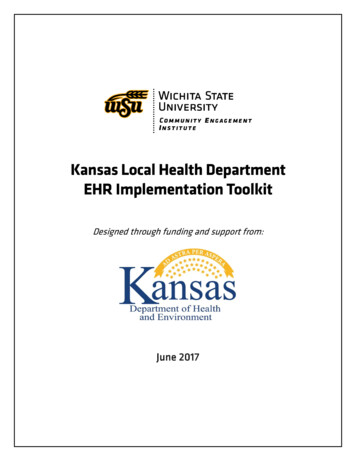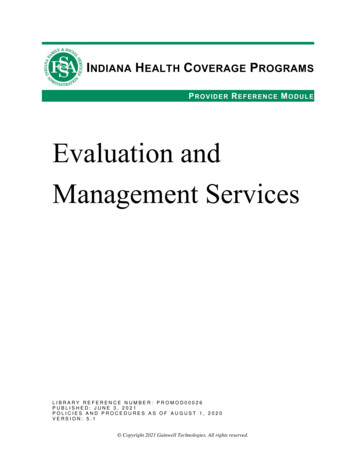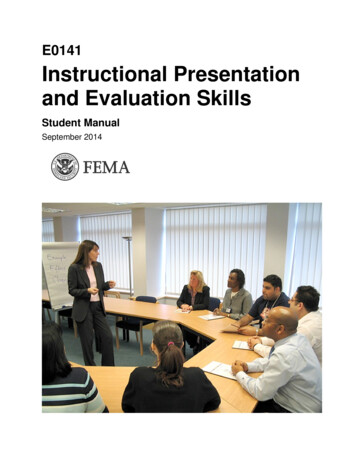
Transcription
E0141Instructional Presentationand Evaluation SkillsStudent ManualSeptember 2014
September 2014E0141 Instructional Presentation and Evaluation SkillsThis page intentionally left blank.Table of Contents
E0141 Instructional Presentation and Evaluation SkillsSeptember 2014Table of ContentsCourse Overview . O-1Unit 1: Creating a Conducive Learning Environment . 1-1Unit 2: Using Instructional Presentation Skills. 2-1Unit 3: Facilitating Interactions . 3-1Unit 4: Managing the Learning Process. 4-1Unit 5: Measuring the Learning Process . 5-1Unit 6: Delivering Instructional Presentations . 6-1Course Summary. S-1Delivery of consistent and comprehensive training to the disaster workforce is key to preparing personnel to performdisaster operations and recovery functions. Changes in training content could adversely impact this critical trainingmission. Therefore, any change to course material must be approved by the Emergency Management Institute incoordination with the respective FEMA program office.Please submit proposed changes to theCourse Manager, Emergency Management Institute, Emmitsburg, Maryland.Table of ContentsSM-i
September 2014E0141 Instructional Presentation and Evaluation SkillsThis page intentionally left blank.SM-iiTable of Contents
E0141 Instructional Presentation and Evaluation SkillsSeptember 2014COURSE OVERVIEWCourse OverviewSM O-1
September 2014E0141 Instructional Presentation and Evaluation SkillsThis page intentionally left blank.SM O-2Course Overview
E0141 Instructional Presentation and Evaluation SkillsSeptember 2014COURSE OBJECTIVESAt the end of this training, you should be able to: Demonstrate the ability to establish a conducive learning environment during a 20-minutepresentation. Demonstrate effective instructional presentation skills. Demonstrate skills for facilitating classroom interactions. Describe ways to manage the learning process. Apply skills to measure training results. Deliver three instructional presentations and participate in their evaluations.APPROXIMATE LENGTH1 hourCONTENTSThis course overview includes the following sections: Welcome Course Opening Activity O.1: “Curious?” Administrative Details Activity O.2: Notable Quotes: Learning and Education Subject Matter Experts/Skilled Presenters Importance of Training/FEMA’s Mission Your Expectations Instructional Team Expectations Course Objectives and Structure Course Materials IntroductionsCourse OverviewSM O-3
September 2014E0141 Instructional Presentation and Evaluation SkillsThis page intentionally left blank.SM O-4Course Overview
E0141 Instructional Presentation and Evaluation SkillsSeptember 2014WELCOMEVisual O-1ACTIVITY O.1: “CURIOUS?”Visual O-2What does curiosity have to do with this course?ADMINISTRATIVE DETAILSDo you have any logistical questions?Visual O-3Course OverviewSM O-5
September 2014E0141 Instructional Presentation and Evaluation SkillsACTIVITY O.2: NOTABLE QUOTES: LEARNING ANDEDUCATIONWorking in your table groups: Visual O-4 Introduce yourself to one another. Name Position and instructional experiencePrepare to introduce the person beside you to the largergroup. Include the person’s name and the followinginformation: Is very experienced. Has done some presentations. Has very little experience. Works in the branch, office, cadre Discuss the quotes. Explain the common theme that related the quotes to eachother. Given this theme, what is one characteristic of an effectivetrainer? Which is the group’s favorite quote? And why? Summarize your work on the chart paper provided. Select aspokesperson. You have 15 minutes.SUBJECT MATTER EXPERTS/SKILLEDPRESENTERS Those who know the topic are sometimes not effectiveinstructors. Good instructors are sometimes not thoroughly familiarwith the topic being presented.Visual O-5SM O-6Course Overview
E0141 Instructional Presentation and Evaluation SkillsSeptember 2014SUBJECT MATTER EXPERT Visual O-6College Professor - Virologist Recognized expert in viruses in turnips Important in study of viruses in humans Noted international speaker Forgets participants’ names Lectures at high level, hard to understand Prolongs classesSKILLED PRESENTER Visual O-7High School Teacher - History Enjoys history Participants, parents like this teacher a lot Is personable, friendly, funny Uses various enjoyable teaching methods Confuses facts Leaves many participant questions unansweredSUBJECT MATTER EXPERT/SKILLED PRESENTERVisual O-8 FEMA is addressing this classic problem. Recognition of the importance of instructional skillscourses is growing. SMEs are learning instructional skills. Presenters are learning the subject matter.IMPORTANCE OF TRAININGVisual O-9Course Overview FEMA emphasizes training. Effective training helps FEMA employees do their workmore effectively. Effective training leads to better service to applicants. Better service to applicants means we are accomplishingFEMA’s mission.SM O-7
September 2014E0141 Instructional Presentation and Evaluation SkillsFEMA’S MISSIONFEMA’s mission is to support our citizens and first respondersto ensure that as a nation we work together to build, sustain,and improve our capability to prepare for, protect against,respond to, recover from, and mitigate all hazards.Visual O-10YOUR INSTRUCTIONVisual O-11SM O-8 Opportunity to improve instructional skills. You have reason to teach well. You are an SME, an expert. Others need to know what you know. Course is an opportunity to learn About learning About teachingCourse Overview
E0141 Instructional Presentation and Evaluation SkillsSeptember 2014PERSONAL TEACHING SKILLSThere are several things about this course that are unique andspecial. We’ll go over them now, and then talk about them asyou see them in the course. We hope that you’ll adopt theminto your style of teaching.Emphasis on Personal Teaching SkillsVisual O-12The teacher does the teaching, and delivers the content, withhis or her Love of learning and teaching Enthusiasm for the content Knowledge of the content Support and respect for the participants and their learning A lot of eye contact Voice Inclusive gesturesTeaching With Enthusiasm If you feel good about your topic, you will teach withenthusiasm. Have a deep understanding of your content. Provide the passion; magical things can happen in theclassroom.A De-Emphasis on PowerPointCourse Overview PowerPoint is not the instruction. PowerPoint visuals areused in support of the instruction, and for review of topics. Make sure you use them as needed to cover the material,but do not lead with PowerPoint.SM O-9
September 2014E0141 Instructional Presentation and Evaluation SkillsAwareness and Understanding of Adult LearningCharacteristics The instructor knows that his/her audience is made up ofindividuals who have a lot of experience and knowledge,and that they like having opportunities to share thosethings. The instructor respects the various learning styles of theadults in the room. He/She should keep things interesting and intellectuallystimulating. He/She should provide positive reinforcement andfeedback.Gaining Participation Ask a lot of questions and ask them well and carefully. Make sure participants understand that a mistake is a goodthing. Encourage participants to respond to each other.Establishing a Safe, Supportive, Respectful Environment You are a peer of your participants. Everyone in theclassroom can add to the general understanding; everyonewalks away with new ideas.* Provide examples of respectful communication and modelit.* Recognize respectful feedback.* Pailol Newsletter, Timothy Clapper, July 2010, Vol 3, Issue 2.What is something that you have learned about in your life thatis exciting to you? Is it scuba diving? Is it weaving? Is ithunting? Is it jewelry? Is it golf? Is it baseball? Is it cooking?Is it history?YOUR EXPECTATIONSWhat expectations do you have for this training?Visual O-13SM O-10Course Overview
E0141 Instructional Presentation and Evaluation SkillsSeptember 2014OUR EXPECTATIONSWe expect you to:Visual O-14 Participate actively during training. Be open to learning and receiving feedback. Be respectful of yourself, others, instructors, and materials. Make three practice presentations. Create and Present an “Opening” (Duo). Make a Simple 3-Minute Presentation (Solo). Conduct a 20-Minute Unit Segment (Solo).COURSE OBJECTIVESBy the completion of this course, you should be able to: Demonstrate the ability to establish a conducive learningenvironment during an effective 20-minute presentation. Demonstrate effective instructional presentation skills.Visual O-15 Demonstrate skills for facilitating classroom interactions. Describe ways to manage the learning process. Apply skills to measure training results. Deliver three instructional presentations and participate intheir evaluations.Visual O-16Course OverviewSM O-11
September 2014E0141 Instructional Presentation and Evaluation SkillsCOURSE STRUCTUREVisual O-17 Unit 1: Establishing a Conducive LearningEnvironment—This unit focuses on cross-culture issues,adult learning characteristics, learning styles andpreferences, and enhancing learning. Participants have anopportunity to practice techniques to enhance learningwhile addressing an adult learning characteristic in shortpresentations. Unit 2: Using Instructional Presentation Skills—Thisunit provides tips on making effective presentationsincluding voice variation, gestures, and more. Participantsconsider barriers and strategies for attending to courseparticipants. Participants have an opportunity to make briefpresentations that describe their later, longer presentations,and to focus on presentation skills. Unit 3: Facilitating Interactions—In this unit,participants discuss techniques for involving courseparticipants, asking effective questions, responding toanswers by listening and paraphrasing, and leadingexercises and discussions. Participants complete aListening Self-Assessment and discuss difficult participantsituations. Unit 4: Managing the Learning Process—This unitprovides the basis for discussing classroom and equipmentpreparation. Participants consider preparation within theinstructional team. Other discussions include access andfunctional needs, course content, and timingconsiderations. Unit 5: Measuring the Learning Process—This unitcontains a directed activity on developing measurablelearning objectives and discussion of how essential theyare to effective training. Participants become acquaintedwith Kirkpatrick’s Evaluation Model, and discuss the typesand results of a training evaluation. Unit 6: Delivering Instructional Presentations—Thisunit addresses the final preparation of an instructor beforepresenting. The unit emphasizes the importance ofpreparing for the delivery. No instructor can just “WingIt.” Participants will quickly realize that the instructor hasnot prepared. As part of the preparation, the instructor musthave a complete understanding of the material, to includecompletion of the activities. Additionally, guidance isgiven on the final presentation.SM O-12Course Overview
E0141 Instructional Presentation and Evaluation SkillsSeptember 2014COURSE MATERIALS Student Manual/CD Job Aids Evaluation FormVisual O-18THE BEST FOR LAST: INTRODUCTIONSVisual O-19Course Overview Give your name and title (again). Name something that you really like to do; this can be your“story” when you are teaching. Tell which TV program was your favorite when you weregrowing up. Take 1 minute.SM O-13
September 2014E0141 Instructional Presentation and Evaluation SkillsGroup 1 Quote: The only thing that interferes with my learning is my education.Albert EinsteinGroup 1 Quote: I cannot teach anybody anything, I can only make them think. SocratesGroup 1 Quote: I have never let my schooling interfere with my education. Mark TwainGroup 1 Quote: Personally I am always ready to learn, although I do not always like beingtaught. Winston ChurchillGroup 1 Quote: It is possible to store the mind with a million facts and still be entirelyuneducated. Alec Bourne , A Doctor’s CreedSM O-14Course Overview
E0141 Instructional Presentation and Evaluation SkillsSeptember 2014Group 2 Quote: Your assumptions are your windows on the world. Scrub them off every oncein a while, or the light won’t come in. Alan AldaGroup 2 Quote: Minds are like parachutes; they work best when open. Lord Thomas DewarGroup 2 Quote: I have never in my life learned anything from any man who agreed with me.Dudley Field MaloneGroup 2 Quote: The highest result of education is tolerance. Helen KellerGroup 2 Quote: People only see what they are prepared to see. Ralph Waldo EmersonGroup 2 Quote: It is what we think we know already that often prevents us from learning.Claude BernardCourse OverviewSM O-15
September 2014E0141 Instructional Presentation and Evaluation SkillsGroup 3 Quote: Learning is what most adults will do for a living in the 21st century.Bob PerelmanGroup 3 Quote: I am learning all the time. The tombstone will be my diploma. Eartha KittGroup 3 Quote: There are no mistakes, no coincidences. All events are blessings given to us tolearn from. Elizabeth Kubler-RossGroup 3 Quote: Anyone who stops learning is old, whether at 20 or 80. Henry FordGroup 3 Quote: The illiterate of the 21st century will not be those who cannot read and write,but those who cannot learn, unlearn, and relearn. Alvin TofflerGroup 3 Quote: Not to know is bad; not to wish to know is worse. African ProverbSM O-16Course Overview
E0141 Instructional Presentation and Evaluation SkillsSeptember 2014Group 4 Quote: Some people talk in their sleep. Lecturers talk while other people sleep.Albert CamusGroup 4 Quote: Good teaching is one-fourth preparation and three-fourths theater. GailGoodwinGroup 4 Quote: You can observe a lot just by watchin.’ Yogi BerraGroup 4 Quote: Learning is finding out what you already know. Richard BachGroup 4 Quote: Spoon feeding in the long run teaches us nothing but the shape of the spoon.E.M. ForsterGroup 4 Quote: Practice is the best of all instructors. Publilius SyrusGroup 4 Quote: You don’t understand anything until you learn it more than one way.Marvin MinskyGroup 4 Quote: It is not the answer that enlightens, but the question.Eugene Ionesco, DécouvertesCourse OverviewSM O-17
September 2014E0141 Instructional Presentation and Evaluation SkillsGroup 5 Quote: They may forget what you said, but they will never forget how you made themfeel. Carl W. BuechnerGroup 5 Quote: To teach is to learn twice. Joseph JoubertGroup 5 Quote: The best teachers teach from the heart, not from the book. Author UnknownGroup 5 Quote: Education is not filling a pail but the lighting of a fire. William Butler YeatsGroup 5 Quote: It’s not what is poured into a participant that counts, but what is planted.Linda ConwayGroup 5 Quote: A teacher who is attempting to teach without inspiring the pupil with a desireto learn is hammering on cold iron. Horace MannGroup 5 Quote: Teaching is the greatest act of optimism. Colleen WilcoxSM O-18Course Overview
E0141 Instructional Presentation and Evaluation SkillsSeptember 2014UNIT 1: CREATING A CONDUCIVELEARNING ENVIRONMENTUnit 1: Creating a Conducive Learning EnvironmentSM 1-1
September 2014E0141 Instructional Presentation and Evaluation SkillsThis page intentionally left blank.SM 1-2Unit 1: Creating a Conducive Learning Environment
E0141 Instructional Presentation and Evaluation SkillsSeptember 2014UNIT OBJECTIVESAt the end of this unit, you should be able to: Discuss the importance of respecting individual differences. Describe the characteristics of adult learning. List adult learning preferences and styles. Discuss instructional methods that engage participants. Describe techniques to enhance learning. With a partner, apply an instructional method that addresses an adult learner characteristic.APPROXIMATE LENGTH3 hours, 30 minutesCONTENTSThis unit includes the following sections: Unit Objectives Activity 1.1: Respecting Individual Differences Sensitive Factors in Presenting Adult Learner Characteristics Adult Learning Preferences Activity 1.2: Learning Styles and Preferences Inventory Methods for Instructing Activity 1.3: Methods for Instructing: Discussion Knowing Your Audience Activity 1.4: Enhancing Learning/Techniques to Enhance Learning Activity 1.5: Duo: 3-Minute Opening Presentation Key Learning Points and Objectives ReviewUnit 1: Creating a Conducive Learning EnvironmentSM 1-3
September 2014E0141 Instructional Presentation and Evaluation SkillsThis page intentionally left blank.SM 1-4Unit 1: Creating a Conducive Learning Environment
E0141 Instructional Presentation and Evaluation SkillsSeptember 2014WELCOMEVisual 1-1UNIT OBJECTIVESVisual 1-2 Discuss the importance of respecting individualdifferences. Describe the characteristics of adult learning. List adult learning preferences and styles. Discuss instructional methods that engage participants. Describe techniques to enhance learning. With a partner, apply an instructional method thataddresses an adult learner characteristic in a 3-minutepresentation.Visual 1-3ACTIVITY 1.1: RESPECTING INDIVIDUALDIFFERENCESVisual 1-4 How did the labels worn by the “actors” affect the waythey were treated by others? How do individual differences affect the way in which youinstruct? What can trainers do to avoid stereotyping?Unit 1: Creating a Conducive Learning EnvironmentSM 1-5
September 2014E0141 Instructional Presentation and Evaluation SkillsSENSITIVE FACTORS IN PRESENTING Visual 1-5 Loss-of-face situations Calling on people unexpectedly Appearing to favor one participant Cutting off or interrupting someoneGender or culturally based analogies, metaphors,expressions, or stories “You know how guys are.” “Women always do that.” “Bubba” “The Hood”Do you have any examples you can share of cross-culturalissues that you have encountered in training situations?SENSITIVE FACTORS IN PRESENTING Offensive symbols or graphics, such as hands folded inprayer. Colors that could be misinterpreted across cultures,perhaps gang colors or political party colors. Offensive jokes or humor; be extremely careful with this.Visual 1-6SM 1-6Unit 1: Creating a Conducive Learning Environment
E0141 Instructional Presentation and Evaluation SkillsSeptember 2014ADULT LEARNER CHARACTERISTIC #1Adults have independent self-concepts, and:Visual 1-7 See themselves as responsible, self-directed, andindependent. Tend to avoid, resist, and resent not being treated likeadults. Should be treated as resources as well as learners. Theyhave learned much. They know a lot of things.What have we already done in this course to take this intoaccount? What are some things that instructors do that can threatenan adult learner’s self-concept? What are some things an instructor can do to enhance alearner’s self-concept? What are some things that instructors do to capitalize on anadult learner’s independence? And on his or herknowledge?ADULT LEARNER CHARACTERISTIC #2Adults are motivated to learn useful information that is usefulto them, and: Learn when they perceive a need or identify disadvantagesof not learning. Are more motivated when a presentation:Visual 1-8 Explains the “why’s.” Is related to personal goals. Focuses on “real-world” situations. What can instructors do to make sure that participants seetheir training as useful? What can you do when your training content is difficult torelate to participants’ personal or professional needs?Unit 1: Creating a Conducive Learning EnvironmentSM 1-7
September 2014E0141 Instructional Presentation and Evaluation SkillsADULT LEARNER CHARACTERISTIC #3Adults need reinforcement, and: Benefit from the positive reinforcement of both instructorsand peers. Do not respond well to punishments or threats. Learn less when they are anxious, fearful, or lackconfidence. Why might participants be anxious during training? What happens to learning when participants help threaten? What is the most creative way you have seen trainersreinforce learning?Visual 1-9SM 1-8Unit 1: Creating a Conducive Learning Environment
E0141 Instructional Presentation and Evaluation SkillsSeptember 2014ADULT LEARNER CHARACTERISTIC #4Adults have large banks of previous learning, and this can helpor hinder the learning process: Participants learn by linking new learning to pastexperiences. Participants may need to “unlearn” previous learning orassumptions.Visual 1-10 They may misinterpret what they hear because ofprevious experience. They may fail to realize they don’t understandcorrectly.What is a common example of needing to unlearn abehavior?FiltersA filter is something you have learned in the past throughwhich you may view things happening currently.For instance, if you’ve been taught that one should not wear abaseball cap indoors and a participant enters your classroomwearing one, you may immediately or momentarily think thatthe participant is doing something wrong.Instructors should try to be aware of their filters and keep themfrom influencing their thinking about participants.Do you have any examples of filters?Unit 1: Creating a Conducive Learning EnvironmentSM 1-9
September 2014E0141 Instructional Presentation and Evaluation SkillsWhat are some techniques that trainers can use to build onprevious learning more effectively? “Build on a topic until it becomes personal for theparticipant; help the participant connect to it personally. If the participant gains a personal connection, the conceptwill be more easily learned and retained.ADULT LEARNING PREFERENCESNote that each individual has preferred learning modesincluding:Visual 1-11 Social Needs: Learning Alone or With Others Motivation: Internal versus External Sources Learning Style: Auditory, Visual, and KinestheticAuditory learners listen carefully to all sounds associated withthe learning. “Tell me” is their motto. They will pay attentionto the sound of your voice and they will participate indiscussions. Speak clearly to them, ask questions, and usephrases like, “How does that sound to you?”Kinesthetic learners need to physically do something tounderstand it. Their motto is “Let me do it.” They trust theirfeeling and emotions about what they’re learning and howyou’re teaching it. They will get up to help with role-playing.You can best communicate with them by involving,volunteers, allowing them to practice what they’re learning,and using phrases like, “How do you feel about that?”Visual learners rely on pictures. They love graphs, diagrams,and illustrations. “Show me” is their motto. They often sit atthe front of the classroom to avoid visual obstructions and towatch you, the teacher. You can best communicate with themby providing handouts, writing on the white board, and usingphrases like, “Do you see how this works?”**5 Principles for the Teacher of Adults, Deb Peterson, About.com Guide.SM 1-10Unit 1: Creating a Conducive Learning Environment
E0141 Instructional Presentation and Evaluation SkillsSeptember 2014Sometimes we talk about the prisoner, the vacationer, and theadventurer as types of participants.What do you think these terms mean?ACTIVITY 1.2: LEARNING STYLES ANDPREFERENCES INVENTORYActivity Objective:Visual 1-12 Identify your own learning preferences. Discuss the implication of differences in participants’preferences for instructors.Learning Preference Inventory Instructions: Complete the Learning Preferences questionnaire. Identify the implications of differences in learningpreferences for instructors. You will have 10 minutes.Unit 1: Creating a Conducive Learning EnvironmentSM 1-11
September 2014E0141 Instructional Presentation and Evaluation SkillsLEARNING STYLES AND PREFERENCES INVENTORYInstructions: Read each statement below. Indicate your level of disagreement or agreement witheach statement by circling a number to the right of the statement.DisagreeNeitherDisagreeNor AgreeAgreeStronglyAgree123451. I learn well by hearing how to dosomething (for example, from atape, a record, or a lecture).123452. I feel that I am self-motivated.123453. I have trouble concentrating whenI am working or studying withother people.123454. I like to draw or use diagramswhen I learn.123455. I like my family or friends toknow that I do a good job atwork.123456. I enjoy learning new things aboutmy work.123457. I prefer to work or study alone.123458. I like my instructors orsupervisors to recognize myefforts.123459. I learn well by trying to do thingsmyself, with my own hands.1234510. The things that I remember bestare the things that I hear.1234511. I learn best by doing on the job.1234512. I get a lot of satisfaction fromdoing the best I can.12345SM 1-12StronglyDisagreeUnit 1: Creating a Conducive Learning Environment
E0141 Instructional Presentation and Evaluation SkillsSeptember 201413. I work better when I know mywork will be checked.1234514. I learn well by seeing how to dosomething (for example, lookingat a diagram or picture, orwatching someone else do it).1234515. I get less done when I work withsomeone else.12345Unit 1: Creating a Conducive Learning EnvironmentSM 1-13
September 2014E0141 Instructional Presentation and Evaluation SkillsSCORE SHEETInstructions: Take your scores from the Learning Styles and Preferences Inventory and entereach item’s answer, or score, where indicated on this score sheet. Add up the item scores undereach category to get an idea of your learning styles and preferences.Emotional Preferences: Social NeedsAlone or With OthersItem #Score3715Total Score A total score of 10 or more indicates that you prefer to learn alone. A total score of 9 or less indicates that you prefer to learn with other people.Emotional Preferences: MotivationExternal MotivationItem #Score5813Total Score A total score of 10 or more indicates that external reinforcements may be important to you. A total score of 9 or less indicates that external reinforcements may not be very important toyou.SM 1-14Unit 1: Creating a Conducive Learning Environment
E0141 Instructional Presentation and Evaluation SkillsSeptember 2014SCORE SHEET (CONTINUED)Emotional Preferences: Motivation (Continued)Internal MotivationI'm proud ofmyself! It's justwhat I wanted.Item #Score2612Total Score A total score of 10 or more indicates that you seem to be self-motivated. A total score of 9 or less indicates that you may or may not be self-motivated.Intellectual Preferences: Learning StylesAuditory LearningItem #Score110Total Score A total score of 7 or more indicates a preference for audio-based learning. You may prefer more than one type of learning, or types of learning may not make adifference to you.Unit 1: Creating a Conducive Learning EnvironmentSM 1-15
September 2014E0141 Instructional Presentation and Evaluation SkillsSCORE SHEET (CONTINUED)Intellectual Preferences: Learning Styles (Continued)Visual LearningA.Item #Score414Total ScoreB.C.D. A total score of 7 or more indicates a preference for visual learning. You may prefer more than one type of learning, or types of learning may not make adifference to you.Kinesthetic Learning (Learn by Doing)Item #Score911Total Score A total score of 7 or more indicates a preference for kinesthetic learning. Kinestheticlearning is learning by doing. You may prefer more than one type of learning, or types of learning may not make adifference to you.SM 1-16Unit 1: Creating a Conducive Learning Environment
E0141 Instructional Presentation and Evaluation SkillsSeptember 2014We see that individuals—including instructors—have differentpreferences.METHODS FOR INSTRUCTING There are theories about which method is best. All methods can be used well. An instructor can develop his/her ability to use numerousmethods. Use methods that help participants meet particular learningobjectives. Use a variety of methods to reach a variety of participantneeds. Use methods that will capture participants’ attention. Use methods that will help participants to think about whatis being taught.Visual 1-13Visual 1-14ACTIVITY 1.3: METHODS FOR INSTRUCTING:DISCUSSIONActivity Objective: Discuss a variety of methods forgenerating interest and attention. Visual 1-15What methods can instructors use that will: generate attention for what is being presented? generate participants’ thinking about what is beingpresented?Unit 1: Creating a Conducive Learning EnvironmentSM 1-17
September 2014E0141 Instructional Presentation and Evaluation SkillsKNOWING YOUR AUDIENCENote that it is important to understand who your targetaudience is. What information do you get before you begin a trainingsession? What can you do if you do not receive any advancedinformation?Can you give an example of a time when you did not knowwho the audience was to be?KNOWING YOUR AUDIENCEVisual 1-16SM 1-18 Do they have any special needs or requirements? What are their motivation levels? Do they know each other? How many are coming to training? Was it their decision to attend the training? How does the training affect their work back on the job? Are there other questions besides those on the visual thatyou can suggest?Unit 1: Creating a Conducive Learning Environment
E0141 Instructional Presentation and Evalua
Demonstrate effective instructional presentation skills. Demonstrate skills for facilitating classroom interactions. Describe ways to manage the learning process. Apply skills to measure training results. Deliv
